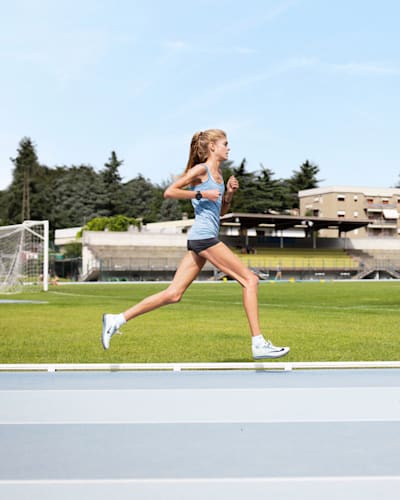
Fitness Training
Get helpful advice from a top runner on sprint, interval and strength training that is guaranteed to improve your performance.
If you're a runner beyond beginner status, you'll soon have your next goal in sight: running your usual distances faster! "Most runners' desire to run faster is about improving their time over the 10km, for example, improving their pace," explains exceptional runner Konstanze Klosterhalfen.
Whether you're eager to up your pace for your weekly park run, your first 10km, or to outrun the Catcher Car for as long as you can at the Wings for Life World Run on May 4, 2025, this easy-to-follow guide will show you the way to faster times so you can set a new personal best!
This is how "running faster" works
The key to a faster running pace is varied training. Most amateur runners run the same distance at the same pace two or three times a week. This trains endurance, but does not help you improve your pace. On the contrary, if you don't train with enough variety, you quickly reach a plateau and - despite regular training - don't really progress. This is something to keep in mind as you step up your training for the Wings for Life World Run.
"You improve your pace by varying your training and not just doing endurance runs where you run at the same pace all the time," Klosterhalfen says. "To get faster, you have to include tempo runs in your training week every now and then in addition to your endurance runs."
You can improve your pace by doing tempo runs or intervals once or twice a week in addition to your long runs.
Three tempo units for success
- Interval running: With interval training, you set yourself a fixed, rather short distance that you run comparatively fast and more often. Between each run you take a one-to-two minute break. For example, 4 x 800m, with a two minute walk break in between. The fitter you become, the more often you can run the 800m. Another progression is to shorten the walk breaks between efforts.
- Tempo run: The tempo run usually takes place at 80-85 percentage of your maximum heart rate. In this range you run a predefined distance or time at a stretch. This can be a few kilometers or 15 minutes in the beginning, but later, when you are fitter, you can run up to 45 minutes and 10 kilometers. Important for tempo running: Don't go too fast! If you overpace at the beginning, you lose.
- Driving game: The driving game is a tempo change run without prescribed rules and is therefore often the most fun for most runners. In the driving game, it is up to the runner to decide when to increase the pace and for how long until the maximum sprint is reached, and when to reduce the pace again and for how long and to take breaks from trotting or walking. The only important thing is that the ratio between load and recovery must be right. As a rule of thumb you can say: the longer a fast pace section was, the longer and slower the recovery section must be.
This running mix gives you wings
Based on the tempo units presented above, a sample training week for runners who want to improve their tempo should look something like this:
- Unit #1: Endurance run - medium pace, medium distance (Tuesday)
- Unit #2: Interval run, tempo run or road race (Thursday)
- Unit #3: Long run - slower pace, longer distance (Sunday)
Strength training as an extra boost
"Supplementary strength training helps to improve and strengthen your stride and footprint," says Klosterhalfen, speaking from her own experience: "Strength training definitely gives you more power for running and, above all, enables you to maintain a faster stride even when it hurts." And that's what tempo training will and should do - but in a good way.
As an extra boost for one's running pace, Klosterhalfen recommends a strength training circuit with one's own body weight, which includes the following eight exercises and may be completed once a week in addition to the three running sessions described above:
01
Squats
The Air Squat is one of the most effective leg exercises of all - even without additional weights, squats strengthen your legs and torso in the long term.
How to do it: Start in a standing position, legs slightly over shoulder width, toes pointing forward and very slightly outward, arms extended straight in front of the body. Hold upper body upright. Now lower your buttocks slowly and in a controlled manner as far as you can while keeping your upper body straight. Then press forcefully back to the starting position. Repeat this exercise 10-20 times. Depending on your fitness level, you can do two to three sets before moving on to the next exercise.
Progression: Advanced exercisers can also do squats with a barbell and slowly increasing weight.
02
Lunges with ground contact
Lunges, strengthen all your leg muscles and especially your glutes and hamstrings.
How to do it: Start in a shoulder-width stance with your toes pointing forward, your torso upright and your core muscles slightly tensed. Now take a dynamic step forward and lower your upper body as upright as possible over your front knee towards the floor until your index fingers touch the floor next to your front foot. Your back knee should also lightly touch the floor. From here push forcefully back to the starting position and repeat the exercise with the other leg. Repeat this exercise 10-15 times. Depending on your fitness level, you can do two to three sets before moving on to the next exercise.
Progression: Advanced exercisers can do this exercise with dumbbells in their hands.
03
Push-ups or bench press
Push-ups work every muscle in your body, but especially your arm, chest and shoulder muscles.
How to do it: Start in prone position, legs stretched together, toes on the floor, palms flat on the floor at chest level, fingers pointing forward. From this position, push yourself powerfully upwards until your arms are fully extended. Keep your body firm and straight like a board. Then lower your body back towards the floor until your chest just touches the floor. Repeat this exercise 10-20 times. Depending on your fitness level, you can do two to three sets before moving on to the next exercise.
Simplified: If you find this type of push-up too difficult, you can place your knees on the floor instead of your toes and push yourself up and down from this position.
04
Rowing with dumbbells
Rowing with dumbbells is another functional whole-body exercise. It especially trains your back and shoulder muscles.
Here's how it works: Start in a slightly over-shoulder-width stance one arm's length away from a weight bench, your knees slightly bent, your upper body upright. Ensure the dumbbells lie on the floor between your feet and the weight bench. Now bend your upper body forward until you have a 90-degree angle at the hips. Rest one hand on the bench and grip the dumbbell with the other. From here pull the dumbbell slowly and in a controlled manner towards your belly button next to your body. Keep your back straight and your upper body stable. Then slowly return the dumbbell to the starting position. Repeat this exercise 10-15 times. Depending on your fitness level you can do two to three sets before moving on to the next exercise.
05
Deadlift (with barbell)
Next to the bench press, the deadlift is considered the supreme exercise in weight training. It is also a real game-changer for runners who want to get stronger and faster.
Here's how it works: Start in a slightly over-shoulder-width stance in front of a barbell. You should stand so close to the barbell that your shins touch the barbell. Now bend forward over your hips with your upper body straight and grasp the barbell in a wide grip to the left and right of your knees. From here pull the barbell powerfully upwards in a line from the floor by extending your hips. Keep your upper body and arms straight and stable. Then return the barbell to the floor. Repeat this exercise 10-15 times. Depending on your fitness level you can do two to three sets before moving on to the next exercise.
Important: Until you have internalized the movement sequence, you should only perform the exercise with the barbell, i.e. without additional weight!
06
Biceps curls with dumbbells
For runners, the biceps muscles are important for the powerful swinging of the arms, especially at higher speeds or when running uphill. The biceps curl specifically strengthens the biceps.
How to do it: Stand in a shoulder-width, stable stance with your arms at your sides and your upper body strong. Hold either a barbell or two dumbbells with the appropriate weight in your hands. Face palms forward. Slowly and in a controlled manner bring the weight up towards your chest using only your biceps muscles. Keep your elbows stable and close to your body. Then return the weight to the starting position in a controlled manner. Repeat this exercise 10-15 times. Depending on your fitness level you can do two to three sets before moving on to the next exercise.
07
Triceps pull-up
The counterpart exercise to the Biceps Curl is the Triceps Extension. Strong triceps, like strong biceps, support the arm swing.
How to do it: Start in a shoulder-width stance in front of the pulley. Choose your appropriate weight and grip the pulley with both hands. Now pull your elbows close to the sides of your torso; your hands should be level with your chest. Then hold the pulley and point your hands towards each other. From here stretch your arms down behind you, pulling the pulley down in a controlled manner with your hands apart at the end until your elbows are fully extended. Keep your elbows angled to your torso the entire time. Then slowly bring your hands back to the starting position in a controlled manner. Repeat this exercise 10-15 times. Depending on your fitness level you can do two to three sets before moving on to the next exercise.
08
Shoulder Press
Shoulder press strengthens your shoulder and neck muscles and also contributes to a stronger arm swing.
How to do it: Stand shoulder-width apart in front of a barbell (with appropriate weight). Grasp the barbell slightly above shoulder width and bring it close to your chest in the starting position. Keep knees slightly bent and your upper body upright and strong. From here press the barbell powerfully over your head until your elbows are fully extended and your wrists are in line with your shoulders. Then return the weight to the starting position in a controlled manner. Repeat this exercise 10-15 times. Depending on your fitness level you can do two to three sets before moving on to the next exercise.
Alternative: You can also do the shoulder press with two dumbbells instead of one barbell.
Why do we care about running? There are of course the mental and physical benefits of putting on a pair of trainers and stretching your legs, but the big one is our annual charity run the Wings for Life World Run on May 4, 2025, which raises funds to support spinal cord research. Every year millions run globally for those that can't as they try to outlast the Catcher Car for as far as possible!
Find out how you can take part in the Wings for Life World Run.











